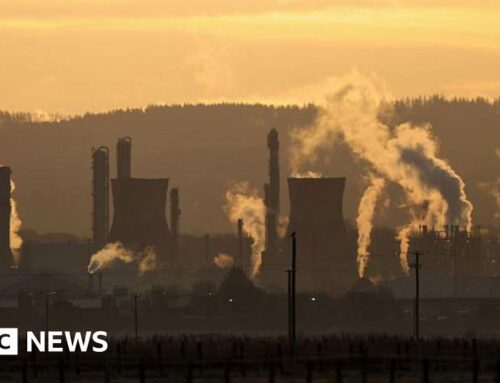Renewable and Low-Carbon Sources Accounted for Over 40% of Global Electricity Production i
April 8, 2025
A mechanical arm of a robot installs solar panels at the construction site of a photovoltaic power project in Jiuquan, Gansu Province of China on Dec. 15, 2024. Cao Hongzu / VCG via Getty Images

Why you can trust us
Founded in 2005 as an Ohio-based environmental newspaper, EcoWatch is a digital platform dedicated to publishing quality, science-based content on environmental issues, causes, and solutions.
A new report has found that 40.9% of global electricity production last year came from “clean,” low-carbon energy sources such as solar and wind power. This number is up from the 39.4% share clean energy had of the total electricity generation mix in 2023.
According to the sixth annual Global Electricity Review from Ember, total global electricity production was comprised of 7% solar, 8% wind, 14% hydropower, 9% nuclear energy and 3% other renewable sources. Major strides in solar and wind energies in particular helped electricity generation from low-carbon sources surpass 40%.
Solar energy has doubled to reach more than 2000 terawatt hours (TWh) over the past three years and for 2024, this energy source was the biggest source of new electricity generation for the third consecutive year, Ember noted. Solar has also been the fastest growing source of electricity generation for the 20th consecutive year as of 2024, the report found.
“Solar power has become the engine of the global energy transition,” Phil MacDonald, managing director at Ember, said in a statement. “Paired with battery storage, solar is set to be an unstoppable force. As the fastest-growing and largest source of new electricity, it is critical in meeting the world’s ever-increasing demand for electricity.”
Solar power production increased particularly in China, where 53% of the increase in solar for 2024 took place. Last year, China set a record for installations of new solar and wind power for the second year in a row.
Although the increasing reliance on clean energy sources was a highlight of Ember’s report, the energy think-tank pointed out that heatwaves in 2024 also led to an increased demand for electricity, some of which was met using higher fossil fuel output.
Global electricity demand increased 4% in 2024 compared to the 2.6% increase in demand in 2023, and electricity generation from fossil fuels increased 1.4% last year. Further, carbon emissions from global energy increased as well, reaching 14.6 billion metric tons — a record high.
According to Ember, the higher temperatures of 2024, which has been deemed the hottest year on record, were the main cause of higher fossil fuel electricity generation. Without the heatwaves, fossil fuel power generation would have increased about 0.2% last year. However, the report authors do not anticipate as high of an increase for this year.
“Amid the noise, it’s essential to focus on the real signal,” MacDonald said. “Hotter weather drove the fossil generation increase in 2024, but we’re very unlikely to see a similar jump in 2025.”
Other factors, including powering artificial intelligence, data centers and EVs, are also contributing to increasing demand, Ember found. The report showed that power demand for these technologies was linked to a 0.7% increase in electricity demand for 2024.
However, the authors are optimistic that increasing demand for technology will be met with an increase in clean power sources over fossil fuels in the future.
“The world is watching how technologies like AI and EVs will drive electricity demand,” MacDonald said. “It’s clear that booming solar and wind are comfortably set to deliver, and those expecting fossil fuel generation to keep rising will be disappointed.”
Search
RECENT PRESS RELEASES
Related Post




